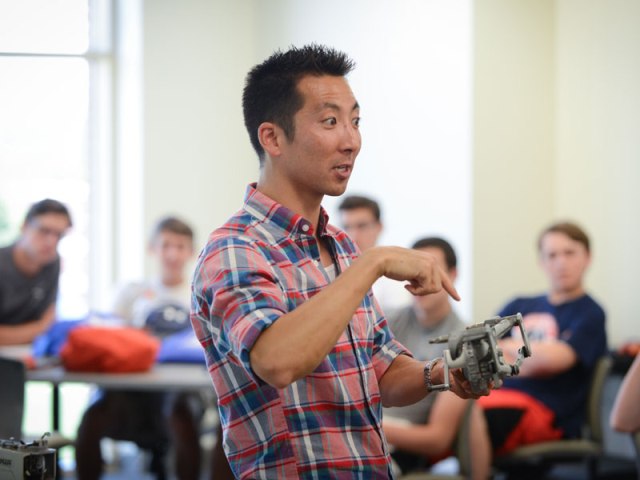Nov 12 2015
Bucknell University junior Michelle Archambault '17 knows well the good and the bad a spine brace can do. Diagnosed with scoliosis, a sideways curvature of the spine, while in middle school, she wore a rigid plastic brace for 16 hours a day, every day, for five years. It corrected the problem and kept her from needing surgery, but it was not an experience she'd like to repeat.
 Professor Charles Kim, mechanical engineering
Professor Charles Kim, mechanical engineering
"It was hard to get used to," she said. "It's more uncomfortable than it is painful, but it's not something you want to wear all the time."
Now a biomedical engineering major at Bucknell, Archambault is working with a team of Bucknell and Columbia University engineers and clinicians striving to make life easier for the millions who suffer from scoliosis.
This fall, the team (led by Bucknell Professor Charles Kim, mechanical engineering; Columbia University Professor Sunil Agrawal, mechanical engineering; and Columbia University Medical Center Professor David Royce, pediatric orthopedic surgery) was awarded a $1 million National Science Foundation grant to develop a more dynamic, comfortable back brace.
The device they're designing combines two technologies — flexible compliant mechanisms and robotics — to create a more lightweight, sleek and functional brace.
"The question is, do you need to have something that is this stiff?" Kim asked, holding the hard plastic brace Archambault wore through her high school years (which has now found a temporary home in Kim's lab). "And furthermore, as the spinal correction happens, do you need to have something that always brings your back to the same place, or would you benefit from something more dynamic?"
The group, which also includes Bucknell students Delaney Charney '16 and JB Ring '15 (now pursuing a master's at Bucknell), has created a prototype consisting of three rings that surround the wearer's lower torso, from just above the hip line to just below the breastbone. Compliant mechanisms — flexible, single-piece devices that transfer force by bending — join the rings along the sides of the body, while robotic actuators provide corrective force to keep the spine in alignment.
The device allows the wearer a greater range of motion, especially to bend forward and twist. But that freedom comes at a cost: The motors and batteries to power them add bulk to the brace — something Archambault described as the worst drawback of any spine brace.
"I think I changed their perspective on the bulkiness — I didn't want to wear it because it would stick out and I didn't want people to see it," said Archambault, who never did wear her old brace to school, in spite of one orthopedist's recommendation. "They thought it was more uncomfortable physically, and it was, a little. But it was more the social aspect that kept me from wearing it."
Kim, who has been studying compliant mechanisms for 15 years, has taken that guidance to heart. He and his student researchers are now seeking ways in which the brace's compliant mechanisms and robotics can work together, reducing the number of motors needed and making the brace as small as possible.
Though they're still in the early design phases, Kim and his colleagues have big long-term plans for the project. Eventually they'd like physicians to be able to design their own customized dynamic braces for scoliosis patients.
"There are very few people in the world who know how to design these types of mechanisms. How do we make it so that every orthopedic surgeon would know how to do this?" he asked. "We have to make our design more systematic, so that it can be ported out to others."
The technology the team is designing could have a huge impact — some 30,000 children in the U.S. use a back brace to treat scoliosis each year, and Ring sees potential for the device to help many more patients using other medical devices.
"I think this can be applied to any part of the body, not just the back," Ring explained. "When I get into the field, I'd like to apply this technology to a prosthetic leg that has a knee joint — to eliminate mechanical joints that might be made of steel or bearings."
Years of prototype testing and refinement likely lie ahead before the brace sees clinical use, but for Archambault, the project has already begun to come full circle. During fall break, she traveled to Tampa, Fla., to present on her work at a biomedical engineering conference.
"Another attendee came over and said, 'Man, I wish I had this when I was younger,' because she had worn a scoliosis brace as well," Archambault said. "I realized that it's not just me — my work is affecting other people. That felt really good."